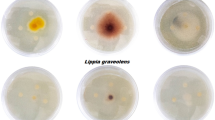Abstract
IN evaluating a number of simple aliphatic amines as volatile post-harvest fungicides for use on citrus fruits, we found that 2-aminobutane (Sec-butylamine) was remarkably effective in reducing decay incited by Penicillium digitatum Sacc.1. Subsequent experiments2 revealed that effectiveness of this amine is mainly due to the fungistatic action of butylammonium salt residues persisting on the fruit after fumigation. In vitro tests showed that germination of Penicillium spores was almost completely inhibited by 10−3 M 2-aminobutane, and, furthermore, that this inhibition could be completely reversed by washing the spores in neutral phosphate buffer, followed by transfer of the spores to amine-free medium. A number of other lower (> C6) primary monoamines were tested by this procedure and found to be ineffective in preventing spore germination. These results prompted an evaluation of 2-aminobutane in fruit washes and wax emulsions for control of Penicillium decay of citrus fruits.
This is a preview of subscription content, access via your institution
Access options
Subscribe to this journal
Receive 51 print issues and online access
$199.00 per year
only $3.90 per issue
Buy this article
- Purchase on Springer Link
- Instant access to full article PDF
Prices may be subject to local taxes which are calculated during checkout
Similar content being viewed by others
References
Eckert, J. W., Kolbezen, M. J., Bretschneider, B. F., and Nicholas, H. K., Phytopath., 51, 64 (1961).
Eckert, J. W., and Kolbezen, M. J., Phytopath. (in the press).
Ruistacher, C. N., and Klotz, L. J., Phytopath., 45, 517 (1955).
Winston, J. R., Meckstroth, G. A., Cubbege, R. H., and Roberts, G. L., U.S. Dept. Agric., Agric. Res. Serv. H. T. and S. Rep. 292 (1953).
Winston, J. R., Meckstroth, G. A., Roberts, G. L., and Cubbege, R. H., U.S. Dept. Agric., Agric. Res. Serv. H. T. and S. Rep. 201 (1949).
Winston, J. R., Meckstroth, G. A., Roberts, G. L., and Cubbege, R. H., U.S. Dept. Agric., Agric. Res. Serv. H. T. and S. Rep. 253 (1951).
Long, J. K., and Roberts, E. A., Austral. J. Agric. Res., 9, 609 (1958).
Harding, P. R., Plant Disease Rep., 46, 100 (1962).
Author information
Authors and Affiliations
Rights and permissions
About this article
Cite this article
ECKERT, J., KOLBEZEN, M. Control of Penicillium Decay of Citrus Fruits with 2-Aminobutane. Nature 194, 888–889 (1962). https://doi.org/10.1038/194888a0
Issue Date:
DOI: https://doi.org/10.1038/194888a0
Comments
By submitting a comment you agree to abide by our Terms and Community Guidelines. If you find something abusive or that does not comply with our terms or guidelines please flag it as inappropriate.



